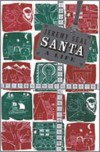|
Book Review
Block up your chimneys
Joanna Kavenna
THIS book begins one ordinary Christmas in Santa's Kingdom at Birmingham's NEC, as Jeremy Seal and his young daughter go to "meet Santa". They find themselves in a "singularly venal world", harassed by a "posse of elves", staring in appalled fascination at a stage where "Frosty the Snowman, a penguin and some majorettes danced and sang". Santa is sitting "on an office chair which did not fit him", in a booth "with walls of green baize slung with fairy lights". This leads Seal into a nightmarish vision of the spirit of Christmas present, a glut of "ceramic Santas ... Santas fashioned from felt cones ... foil-wrapped chocolate Santas ... Santa candles ... Santa finger puppets and Santa Christmas-tree decorations ... plastic Santas kitted out in parachutes ... a battery-powered Santa who played a sax ..." and so on. Rather than throwing in his lot with Scrooge, Seal decides to find out why we all ended up worshipping in the "temple of consumption" and how Santa came to sponsor Coca-Cola.
 |
Santa: A Life
Jeremy Seal |
Seal's life of Santa runs through Turkey, Greece, Russia, Italy, the Netherlands, the USA and finally Lapland, along a trail scattered with intriguing digressions. The story of Santa is a mishmash of Norse, Germanic, Christian, Siberian and Moorish stories, among others. Seal starts with St Nicholas, a fourth-century bishop of Myra in Lycia, a province of Byzantine Anatolia which is now in Turkey. This Nicholas is a pretty obscure character: nothing he wrote survived, and even his dates (c280-352, apparently) are disputed. He gained a local reputation for charity, and the most famous St Nicholas story has him giving dowries to three poor daughters so they wouldn't have to become prostitutes. St Nicholas became the patron saint of seafarers as well as an all-round figure of munificence. In Russia he became Nikolai Ugodnik, or Nicholas the Helper; he was believed to protect houses from fire, guard crops and look after shepherds. His scanty relics were later translated to Bari in southern Italy, and the place became a pilgrimage site.
As the Christian church incorporated local myths, the cult of St Nicholas drew on and subsumed pagan gift-giving figures such as Befana, Berchta and Knecht Ruprecht, as well as the Norse god Odin, who made clandestine visits to people's hearths and sometimes left gifts for them. There are Germanic tales that mingle folk and Christian traditions: in one, the land is terrorised by a monster who comes down the chimneys at night and disembowels children. A St Nicholas-esque holy man defeats the demon and sends him off to distribute reparatory presents to the surviving children. In Protestant Holland, St Nicholas became Sinterklaas, gaining a bizarre sidekick, Zwarte Piet or Black Peter. Dutch immigrants took Sinterklaas with them to America, and it was there, in the early 19th century, that he became Santa Claus, responding to the topical fixation with the far north by gaining a reindeer-driven sleigh.
Seal's is a determinedly irreverent account, and he playfully casts Nicholas as the active arbiter of his own personality cult: a "natural opportunist" who "knew all about the frailty of fortune", posthumously determined to secure his reputation. This is redolent of the approach taken by Washington Irving in his 1809 History of New York, which Seal cites, in which Santa Claus is depicted arriving in America on a boat from Holland "with a low-brimmed hat, a huge pair of Flemish trunk hose, and a pipe that reached to the end of the bowsprit". This personification allows Seal to make light of some of the twists and turns in the Santa story, by attributing them to St Nicholas's trans-temporal genius for reinvention. It also allows for wry comedy and a suitable element of kitsch. Sometimes this approach fills in where historical analysis might have been more interesting, and the Norse and pagan elements of the Santa story are left somewhat vague. Rather, Seal offers a straight decline, from a virtuous Christian saint to the über-glut of the American Christmas. (One might say, rather, that St Nicholas himself is part of a decline, from indigenous folk traditions to the all-subsuming evangelism of Christianity.) Yet Seal's travel descriptions are always lucid and stylish. He is a fine raconteur, and his lively anecdotes draw the narrative along at a cracking pace. He is particularly good on the world-beating excess of the American Christmas, which he lingers on, relishing its gaudy improbability.
For all the horror of sleigh bells, singing and supermarket Santas, Seal can't quite wean his daughters off their fascination. Seeking to make amends for the dancing fairies of the NEC, he ends by taking them to the modern-day Mecca of the Santa cult - Finnish Lapland, where at least the snow is real. In one last irony, Santa: A Life comes packaged as a Christmas present - for those who are forced, kicking and screaming, to celebrate Christmas.
Source: Guardian Unlimited © Guardian Newspapers Limited 2005
Copyright
(R) thedailystar.net 2006
|
